Houseplants have become superstars in the world of interior design, and for good reason. Their visual charm is undeniable, but their benefits extend far beyond aesthetics. These leafy companions act as living air filters, proven to remove common toxins like formaldehyde and benzene from our indoor environments. Studies have also shown that simply being around plants can significantly improve our well-being by reducing stress, boosting mood, and even enhancing creativity and focus. Caring for plants can even be a form of therapy, providing a sense of accomplishment and connection with nature.
Furthermore, indoor plants help regulate humidity levels. By releasing moisture vapor through transpiration, they combat dry air, which can be especially beneficial in drier climates or during winter months, potentially reducing dry skin and respiratory problems.
This comprehensive guide will delve into the world of indoor plants, spotlighting ten top varieties. We’ll provide insights into their unique characteristics, care requirements, and suitability for different light conditions, helping you choose the perfect green companion for your space. So, whether you’re a seasoned plant parent or a curious beginner, this guide will equip you with the knowledge to transform your indoor environment into a thriving oasis.
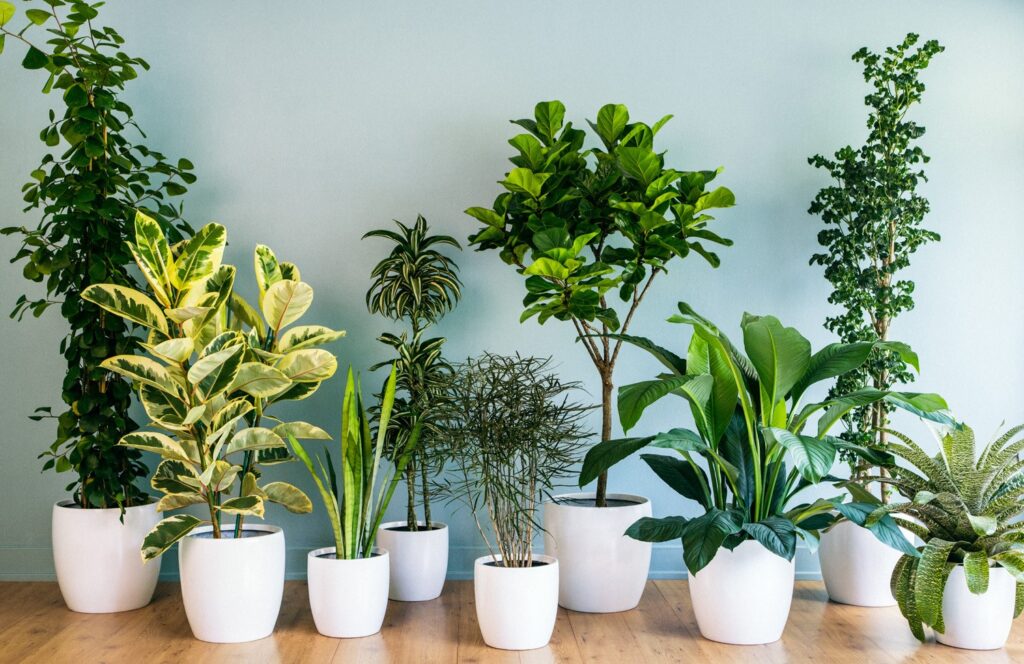
Importance of Indoor Planting:
Indoor plants are more than just decorations for your home or office. They offer a surprising range of benefits, making indoor planting important for both your health and happiness. Here’s a closer look at some key advantages:
- Improved Air Quality: Through photosynthesis, plants absorb carbon dioxide and release oxygen, freshening up the air you breathe. Studies by NASA have shown that certain houseplants can help remove toxins like formaldehyde and benzene, common pollutants found in carpets, furniture, and cleaning products].
- Enhanced Wellbeing: Indoor plants can have a significant impact on your mental and emotional state. Research suggests that having plants around reduces stress, improves mood, and even boosts creativity and focus. Caring for plants can also be a form of therapy, providing a sense of accomplishment and connection with nature.
- Increased Humidity: Plants release moisture vapor through a process called transpiration, helping to increase humidity levels indoors. This can be especially beneficial in drier climates or during winter months, reducing dry skin and respiratory problems.
- Aesthetics and Ambiance: Indoor plants add a touch of life and color to any space, creating a more calming and inviting atmosphere. Studies have shown that people feel more comfortable and relaxed in rooms with plants.
Overall, indoor planting is a simple way to enhance your living or working environment. With a variety of plants to choose from, there’s sure to be a perfect fit for your space and preferences. Just remember to consider factors like sunlight, watering needs, and potential toxicity (if you have pets or children) when selecting your leafy companions.
Planning Your Indoor Garden/Indoor Plants
Before diving into the world of indoor gardening, it’s essential to consider the following factors:
- Light Conditions: Assess the natural light availability in your indoor space. Different plants have varying light requirements, so choose plants that are well-suited to the light levels in your home or office. For example, low-light plants like Snake Plants and Pothos are ideal for spaces with limited sunlight.
- Space Constraints: Consider the available space for your indoor garden and choose plants that fit your space requirements. If you have limited floor space, consider vertical gardening options or hanging planters to maximize space utilization.
- Maintenance Level: Be realistic about the amount of time and effort you can dedicate to plant care. Some plants require more maintenance than others, so choose varieties that align with your lifestyle and gardening preferences. Low-maintenance plants like Succulents and Snake Plants are perfect for busy individuals or beginners.
- Aesthetic Preferences: Think about the overall aesthetic you want to achieve with your indoor garden. Whether you prefer lush foliage, flowering plants, or minimalist greenery, select plants that complement your interior decor style and personal taste.
By carefully considering these factors and selecting the right indoor plants for your space, you can create a thriving indoor garden that enhances your environment and brings the beauty of nature indoors. Here are some popular options for indoor plants including their plating guide:
1. Spider Plant
| Scientific Name | Chlorophytum comosum |
| Plant Type | Perennial |
| Family/Genus | Asparagaceae |
| Plant Size | Small to Medium |
| Fragrant | No |
| Geographical Region | Native to South Africa |
Description: The Spider Plant, scientifically known as Chlorophytum comosum, is a beloved choice for indoor spaces due to its elegant arching foliage and air-purifying properties. Originating from South Africa, this perennial plant produces long, slender leaves adorned with small white flowers. Its ability to produce “pups” or baby plants makes it an excellent option for propagation, allowing you to expand your green collection effortlessly.
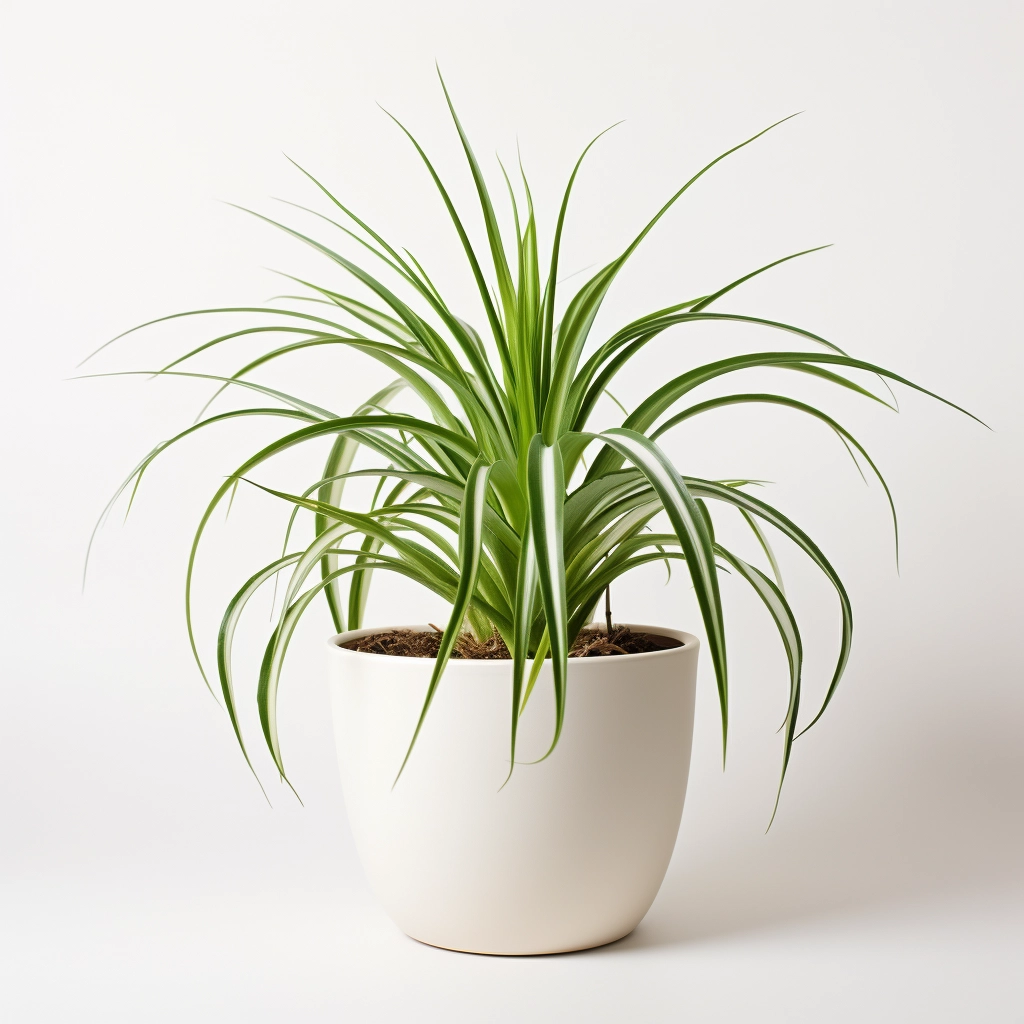
- Varieties:Common varieties include the traditional green and white striped Chlorophytum comosum, as well as solid green varieties and curly or variegated leaf types.
- Planting: Spider plants thrive in well-draining soil. They’re adaptable to various light conditions but prefer bright, indirect sunlight. They can be planted in pots or hanging baskets.
- Watering: Water moderately, allowing the soil to dry out between waterings. Overwatering can lead to root rot, so it’s crucial to ensure proper drainage.
- Fertilizing: Feed with a balanced fertilizer diluted to half-strength once a month during the growing season (spring and summer). Avoid over-fertilization, as it can damage the plant.
- Pruning: Trim off any brown or yellow leaves to maintain the plant’s appearance. Remove any flower stalks that appear, as spider plants are primarily grown for their foliage.
- Pest and Disease Management: Spider plants are generally resistant to pests and diseases. However, occasional issues with spider mites or mealybugs may occur. Treat infestations with insecticidal soap, and ensure good air circulation to prevent fungal diseases.
2. Peace Lily
| Scientific Name | Spathiphyllum |
| Plant Type | Perennial |
| Family/Genus | Araceae |
| Plant Size | Medium to Large |
| Fragrant | Yes |
| Geographical Region | Native to Americas, Southeast Asia |
Description: The Peace Lily is a striking indoor plant known for its elegant white flowers and glossy green leaves. Native to tropical regions of the Americas and Southeast Asia, this perennial species thrives in warm, humid conditions, making it an excellent choice for bathrooms or kitchens. In addition to its ornamental value, Peace Lilies are also effective air purifiers, removing toxins such as formaldehyde and benzene from the air.
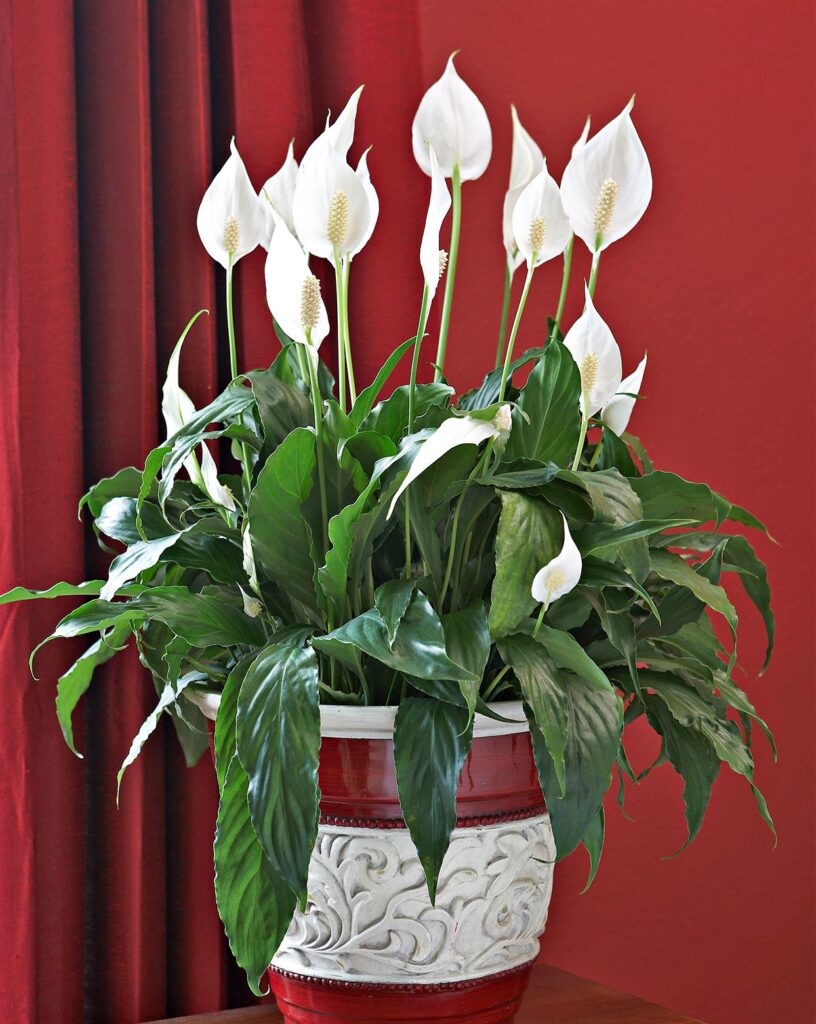
- Varieties: The most common varieties include Spathiphyllum wallisii and Spathiphyllum floribundum. They are known for their lush, dark green leaves and white flowers.
- Planting:Plant in well-draining soil with indirect sunlight. Peace lilies can tolerate low light conditions, making them suitable for offices and homes with limited natural light.
- Watering: Keep the soil consistently moist but not waterlogged. Peace lilies are sensitive to overwatering, which can lead to root rot. Allow the top inch of soil to dry out slightly between waterings.
- Fertilizing: Feed with a balanced liquid fertilizer diluted to half-strength every 6-8 weeks during the growing season. Avoid fertilizing during the winter months.
- Pruning: Remove dead or yellow leaves and spent flowers to encourage new growth and maintain the plant’s appearance. Use sterile pruning tools to prevent the spread of diseases.
- Pest and Disease Management: Peace lilies are relatively pest-resistant but may occasionally attract pests like aphids, mealybugs, or scale insects. Treat infestations with insecticidal soap. Overwatering can lead to root rot and fungal diseases, so ensure proper drainage and avoid waterlogging the soil.
3. Rubber Plant
| Scientific Name | Ficus elastica |
| Plant Type | Perennial |
| Family/Genus | Moraceae |
| Plant Size | Large |
| Fragrant | No |
| Geographical Region | Native to Southeast Asia |
Description: The Rubber Plant is a classic choice for indoor greenery, prized for its glossy, burgundy-colored leaves and upright growth habit. Native to Southeast Asia, this evergreen tree can grow quite tall indoors, making it a striking focal point in any room. Rubber Plants are known for their resilience and ability to thrive in low light conditions, making them ideal for offices or areas with limited sunlight.
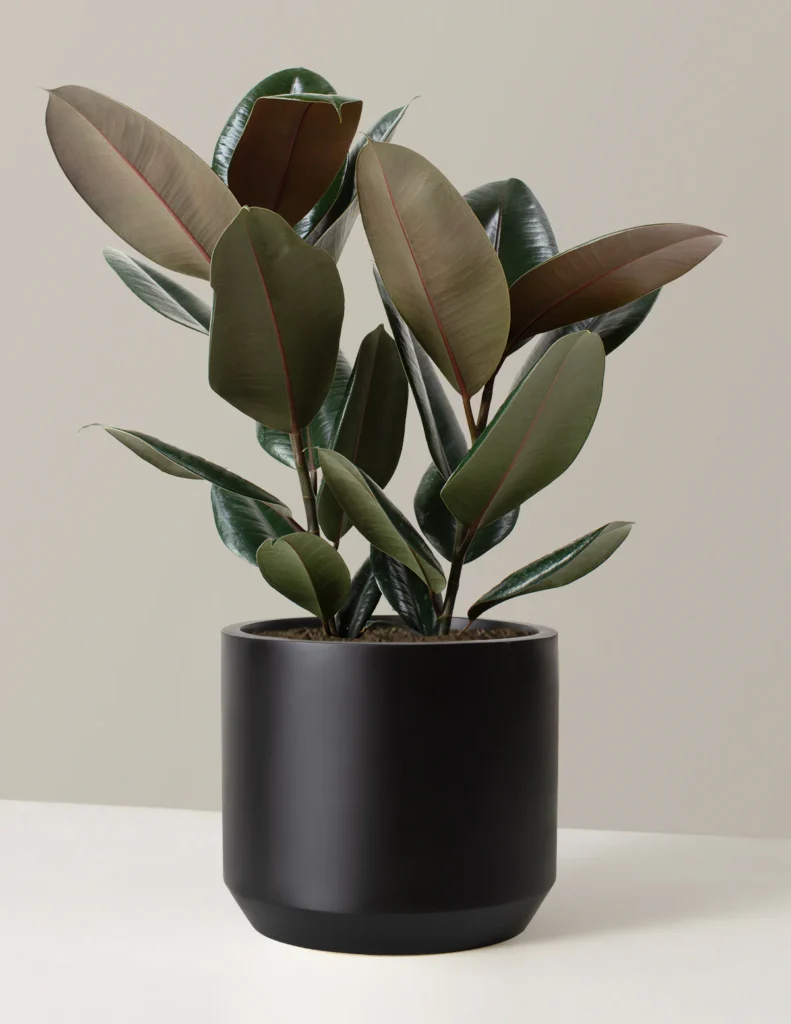
- Varieties: The most common variety is Ficus elastica, known for its large, glossy leaves. There are also variegated cultivars available.
- Planting: Plant in well-draining soil with bright, indirect sunlight. Rubber plants can tolerate some direct sunlight but may scorch in intense light. They prefer temperatures above 60°F (15°C).
- Watering: Water when the top inch of soil feels dry, usually every 1-2 weeks. Allow excess water to drain away to prevent waterlogging, which can cause root rot.
- Fertilizing:Feed every 2-4 weeks during the growing season with a balanced liquid fertilizer diluted to half-strength. Reduce fertilization during the winter months when growth slows down.
- Pruning:Prune to control size and shape, cutting just above a leaf node. Wipe the sap that oozes from cuts with a damp cloth to prevent irritation.
- Pest and Disease Management: Rubber plants are relatively resistant to pests, but they may occasionally attract mealybugs, scale insects, or spider mites. Keep an eye out for signs of infestation and treat with insecticidal soap if necessary. Overwatering can lead to root rot, while underwatering can cause leaf drop and dryness, so strive for balanced watering practices.
4. Elephant Ear Plant
| Scientific Name | Alocasia |
| Plant Type | Perennial |
| Family/Genus | Araceae |
| Plant Size | Large |
| Fragrant | No |
| Geographical Region | Native to Southeast Asia, Pacific Islands |
Description: The Elephant Ear Plant is renowned for its large, heart-shaped leaves and tropical vibe. Native to Southeast Asia and the Pacific Islands, this perennial plant adds a touch of drama to any indoor space with its striking foliage. Elephant Ear Plants thrive in warm, humid environments and require regular watering to maintain optimal growth.
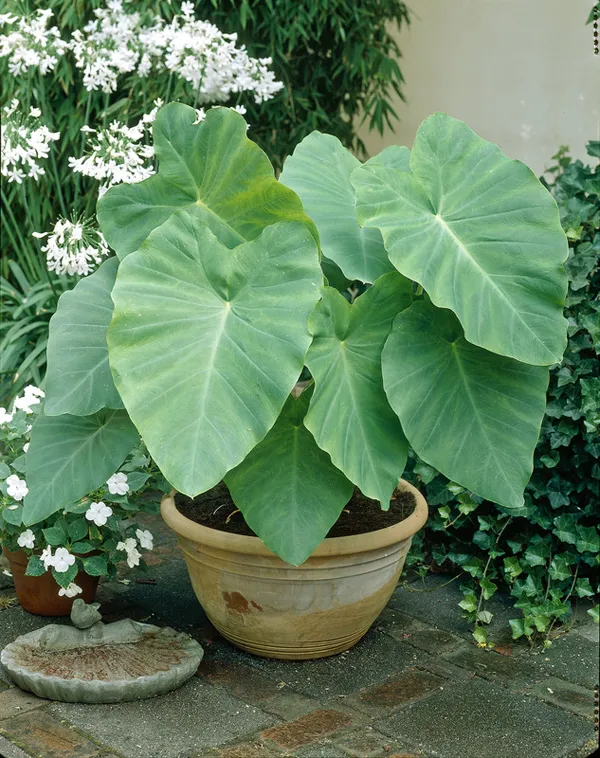
- Varieties: Elephant ear plants belong to the genera Alocasia and Colocasia, with numerous cultivars available. Common varieties include Alocasia amazonica, Colocasia esculenta, and Colocasia gigantea.
- Planting: Plant in rich, well-draining soil in partial shade to full sun, depending on the variety. Ensure adequate spacing between plants, as they can grow quite large.
- Watering: Keep the soil consistently moist but not waterlogged. Elephant ear plants prefer high humidity, so misting the leaves regularly or placing a humidity tray nearby can help.
- Fertilizing: Feed every 2-4 weeks during the growing season with a balanced liquid fertilizer diluted to half-strength. Avoid excessive fertilization, as it can cause leaf burn.
- Pruning: Remove dead or yellow leaves as needed to maintain plant health and appearance. Prune back any damaged or unsightly stems to encourage new growth.
- Pest and Disease Management: Elephant ear plants are susceptible to pests such as aphids, spider mites, and caterpillars. Inspect the foliage regularly and treat any infestations promptly with insecticidal soap or neem oil. Additionally, watch out for fungal diseases like leaf spot and root rot, which can occur in overly moist conditions. Ensure good air circulation around the plants and avoid overhead watering to minimize the risk of fungal infections.
5. Snake Plant
| Scientific Name | Sansevieria trifasciata |
| Plant Type | Succulent |
| Family/Genus | Asparagaceae |
| Plant Size | Medium to Large |
| Fragrant | No |
| Geographical Region | Native to West Africa |
Description: The Snake Plant, scientifically known as Sansevieria trifasciata, is a resilient and low-maintenance indoor plant native to West Africa. Its stiff, upright leaves come in various shades of green, making it an excellent choice for adding vertical interest to any space. Snake Plants are renowned for their air-purifying abilities, making them ideal for bedrooms or offices where clean air is essential.

- Varieties:Sansevieria trifasciata is the most common variety, but there are several other species and cultivars available, including Sansevieria cylindrica and Sansevieria masoniana. Varieties differ in leaf shape, size, and coloration.
- Planting: Snake plants prefer well-draining soil and can tolerate a wide range of light conditions, from low to bright indirect light. They are suitable for indoor or outdoor cultivation in warm climates.
- Watering: Allow the soil to dry out between waterings, as snake plants are sensitive to overwatering. Water sparingly, especially during the winter months when growth slows down.
- Fertilizing: Snake plants are not heavy feeders and can thrive without frequent fertilization. If desired, feed with a balanced liquid fertilizer diluted to half-strength every 2-3 months during the growing season.
- Pruning: Trim off any dead or yellow leaves as needed, but avoid excessive pruning, as snake plants typically have slow growth rates.
- Pest and Disease Management: Snake plants are generally resistant to pests and diseases, making them low-maintenance houseplants. However, overwatering can lead to root rot, while underwatering may cause leaf shriveling. Watch out for signs of pests such as spider mites or mealybugs, especially in indoor environments with low humidity.
6. Aloe Vera
| Scientific Name | Aloe barbadensis miller |
| Plant Type | Succulent |
| Family/Genus | Asphodelaceae |
| Plant Size | Small to Medium |
| Fragrant | No |
| Geographical Region | Native to Arabian Peninsula, Northern Africa |
Description: Aloe Vera, scientifically known as Aloe barbadensis miller, is a popular succulent prized for its medicinal properties and striking appearance. Native to the Arabian Peninsula and Northern Africa, this versatile plant has been used for centuries for its healing properties, particularly for soothing burns and skin irritations. Aloe Vera’s fleshy leaves contain a gel-like substance rich in vitamins, minerals, and antioxidants, making it a valuable addition to any indoor garden.

- Varieties: Aloe vera is a single species, but there are various cultivars with differences in leaf size, shape, and color. Some cultivars have variegated leaves with white or yellow markings.
- Planting: Plant aloe vera in well-draining cactus or succulent potting mix. Place in a sunny location with at least 6 hours of direct sunlight per day. Aloe vera can also be grown indoors near a sunny window.
- Watering: Allow the soil to dry out completely between waterings, then water deeply until water drains from the bottom of the pot. Water less frequently during the winter months when growth slows down.
- Fertilizing: Aloe vera typically does not require fertilization, as it is adapted to nutrient-poor environments. However, you can feed with a balanced liquid fertilizer diluted to quarter-strength once or twice during the growing season.
- Pruning: Remove any dried or damaged leaves by cutting them off at the base with clean, sharp scissors. Aloe vera plants naturally shed older leaves as new ones grow from the center of the rosette.
- Pest and Disease Management:Aloe vera is relatively resistant to pests and diseases, but it may occasionally attract aphids, scale insects, or mealybugs. Inspect the plant regularly for signs of pests, and treat infestations promptly with insecticidal soap. Overwatering can lead to root rot, so ensure the soil dries out between waterings to prevent fungal diseases.
7. Ferns
| Scientific Name | Various species |
| Plant Type | Perennial |
| Family/Genus | Various |
| Plant Size | Small to Large |
| Fragrant | No |
| Geographical Region | Native to various regions globally |
Description: Ferns are a diverse group of plants known for their lush foliage and delicate fronds. They come in various species, each with its unique characteristics. Ferns thrive in moist, shaded environments, making them ideal for bathrooms or areas with high humidity. They add a touch of elegance and natural beauty to any indoor space.
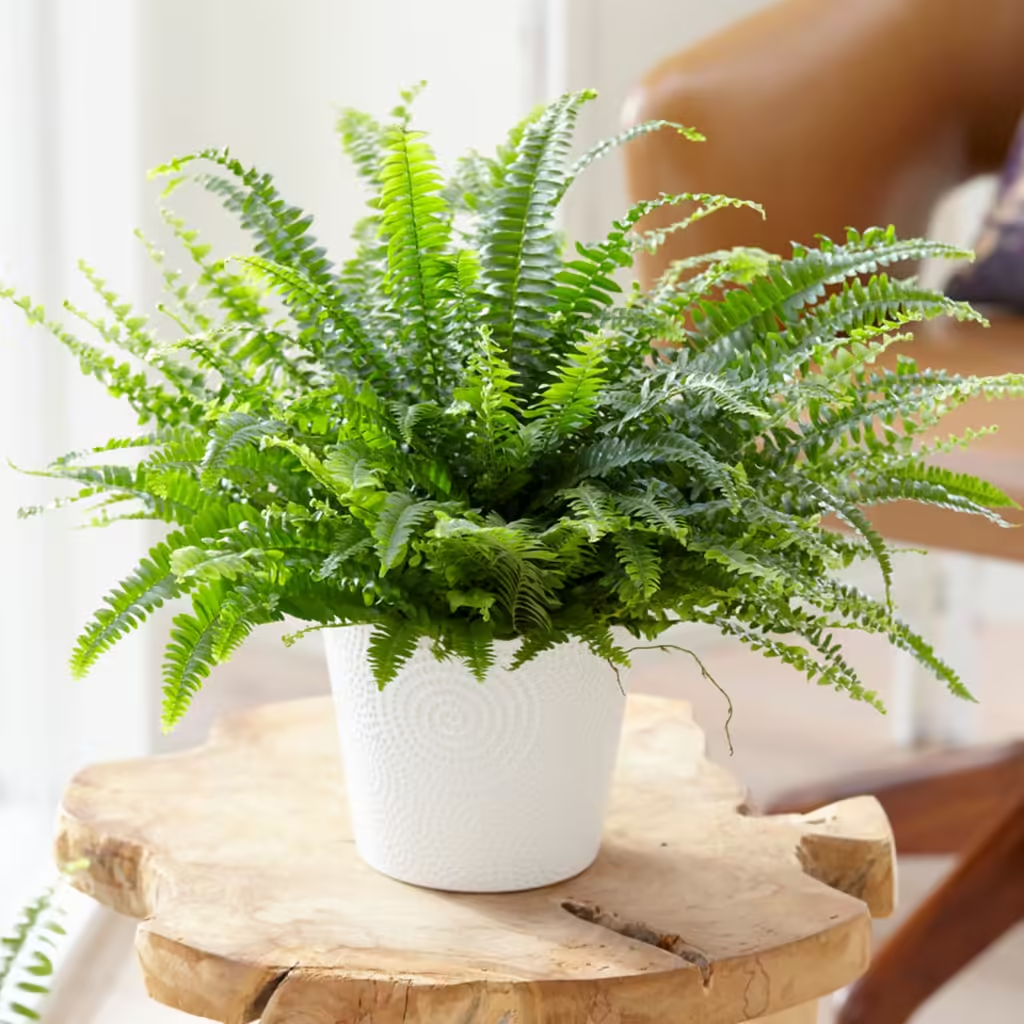
- Varieties: Ferns encompass a diverse group of plants, including Boston ferns, maidenhair ferns, bird’s nest ferns, and many others. Each variety has its own unique characteristics, such as leaf shape, texture, and growth habit.
- Planting: Plant ferns in well-draining, moisture-retentive soil enriched with organic matter. Choose a location with indirect sunlight or partial shade, as ferns prefer filtered light conditions.
- Watering: Keep the soil consistently moist but not waterlogged. Water ferns regularly, especially during hot and dry periods, and mist the foliage frequently to maintain high humidity levels.
- Fertilizing: Feed ferns every 4-6 weeks during the growing season with a balanced liquid fertilizer diluted to half-strength. Avoid over-fertilizing, as ferns are sensitive to excess nutrients.
- Pruning: Remove dead or yellow fronds by cutting them off at the base of the plant. Regular pruning helps maintain the plant’s appearance and promotes healthy growth.
- Pest and Disease Management: Ferns are susceptible to pests such as aphids, scale insects, and mealybugs, as well as fungal diseases like rust and powdery mildew. Inspect the foliage regularly for signs of pests or diseases, and treat infestations promptly with insecticidal soap or fungicide.
8. Pothos
| Scientific Name | Epipremnum aureum |
| Plant Type | Vine |
| Family/Genus | Araceae |
| Plant Size | Small to Large |
| Fragrant | No |
| Geographical Region | Native to Solomon Islands |
Description: Pothos, scientifically known as Epipremnum aureum, is a versatile and low-maintenance indoor plant prized for its trailing vines and heart-shaped leaves. Native to the Solomon Islands, this vine species is a popular choice for hanging baskets and elevated surfaces. Pothos is renowned for its adaptability and ability to thrive in a variety of light conditions, making it an excellent choice for both beginners and experienced plant enthusiasts.

- Varieties: Epipremnum aureum, commonly known as pothos or devil’s ivy, has several cultivars with variations in leaf color and pattern. Popular cultivars include ‘Golden Pothos,’ ‘Marble Queen,’ and ‘Neon Pothos.’
- Planting: Pothos are versatile plants that can thrive in a variety of light conditions, from low to bright indirect light. Plant in well-draining soil and allow the soil to dry out between waterings.
- Watering: Water pothos when the top inch of soil feels dry. Avoid overwatering, as it can lead to root rot. Pothos are drought-tolerant and can withstand occasional periods of neglect.
- Fertilizing: Feed pothos every 4-6 weeks during the growing season with a balanced liquid fertilizer diluted to half-strength. Avoid fertilizing during the winter months when growth slows down.
- Pruning: Trim long stems as needed to maintain the desired size and shape of the plant. Pruning encourages bushier growth and prevents the plant from becoming leggy.
- Pest and Disease Management: Pothos are relatively resistant to pests and diseases, but they may occasionally attract mealybugs or spider mites, especially if grown in dry indoor environments. Inspect the foliage regularly for signs of pests, and treat infestations promptly with insecticidal soap. Avoid overwatering to prevent root rot and fungal diseases.
9. English Ivy
| Scientific Name | Hedera helix |
| Plant Type | Vine |
| Family/Genus | Araliaceae |
| Plant Size | Small to Medium |
| Fragrant | No |
| Geographical Region | Native to Europe, Western Asia |
Description: English Ivy, scientifically known as Hedera helix, is a versatile vine prized for its lush foliage and ability to climb and trail. Native to Europe and Western Asia, this evergreen plant is commonly used as ground cover or in hanging baskets. English Ivy adds a touch of elegance and natural beauty to any indoor space and is relatively easy to care for, making it a popular choice for both beginners and experienced gardeners.

- Varieties: English ivy (Hedera helix) has various cultivars, including ‘Gold Child,’ ‘Glacier,’ and ‘Needlepoint,’ each with distinct leaf shapes and variegation patterns.
- Planting: Plant English ivy in well-draining soil with partial to full shade. It can tolerate a wide range of light conditions but prefers indirect sunlight. Ensure good air circulation to prevent fungal issues.
- Watering: Water regularly to keep the soil evenly moist but not waterlogged. Allow the top inch of soil to dry out between waterings, especially during the winter months.
- Fertilizing:Feed with a balanced liquid fertilizer diluted to half-strength every 4-6 weeks during the growing season. Avoid over-fertilizing, as it can lead to excessive vine growth with reduced leaf size.
- Pruning: Trim back overgrown or leggy stems to encourage bushier growth. Remove any dead or yellowing leaves to maintain the plant’s appearance.
- Pest and Disease Management: English ivy is relatively resistant to pests but may attract aphids, spider mites, or scale insects. Inspect the foliage regularly and treat any infestations with insecticidal soap. Watch out for fungal diseases such as powdery mildew or leaf spot, especially in humid conditions.
10. Succulents and Cacti
| Scientific Name | Cactaceae (Various species) |
| Plant Type | Succulent/Cactus |
| Family/Genus | Aloe/Opuntia (Various) |
| Plant Size | Small to Medium |
| Fragrant | No |
| Geographical Region | Native to various regions globally |
Description: Succulents and cacti are popular indoor plants known for their unique shapes, textures, and low-maintenance requirements. They are native to various regions globally and are adapted to arid environments, making them perfect for indoor spaces with dry air. Succulents store water in their leaves or stems, allowing them to thrive with minimal watering. Cacti, with their iconic spines, add a touch of desert charm to any indoor garden.
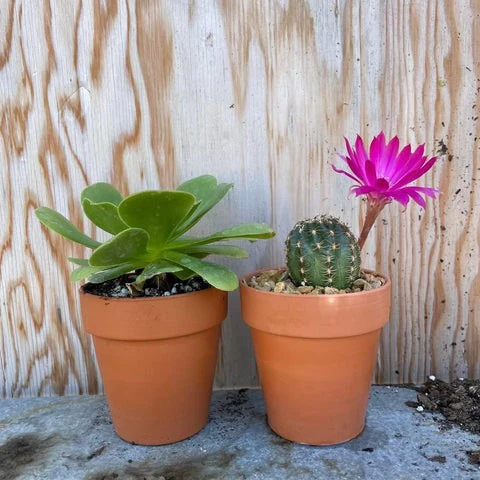
- Varieties: Succulents and cacti comprise a vast array of species and cultivars, each with unique shapes, sizes, and colors. Common succulents include Echeveria, Sedum, and Aloe, while popular cacti include Opuntia, Echinocactus, and Mammillaria.
- Planting: Plant succulents and cacti in well-draining soil, such as a mix of potting soil and perlite or sand. Use containers with drainage holes to prevent waterlogged soil.
- Watering:
- Water sparingly, allowing the soil to dry out completely between waterings. Succulents and cacti are adapted to arid environments and can store water in their leaves or stems.
- Fertilizing: Fertilize sparingly with a diluted succulent or cactus fertilizer during the growing season, typically once every 2-3 months. Avoid excessive fertilization, as it can lead to weak, leggy growth.
- Pruning: Remove dead or damaged leaves or stems as needed to maintain plant health and appearance. Use clean, sharp scissors or pruning shears to make cuts.
- Pest and Disease Management: Succulents and cacti are generally resilient to pests and diseases, but they may occasionally encounter issues such as mealybugs, scale insects, or fungal infections. Inspect the plants regularly and treat any problems promptly with appropriate measures, such as insecticidal soap or fungicide. Overwatering is a common cause of root rot in succulents and cacti, so ensure proper watering practices to prevent this issue.
Conclusion:
In conclusion, indoor plants are not just decorative elements but essential companions that can significantly enhance our living spaces. From the air-purifying properties of Snake Plants and Peace Lilies to the striking foliage of Elephant Ear Plants and Rubber Plants, each species brings its unique charm and benefits to our indoor environments. By understanding the characteristics and care requirements of these top indoor plants, we can create thriving green spaces that not only beautify our homes but also promote well-being and improve air quality. So, whether you’re looking to add a touch of greenery to your office desk or create a lush indoor jungle, these plants offer endless possibilities for creating inviting and harmonious living spaces. Let’s embrace the beauty of nature indoors and reap the rewards of nurturing these green companions. Happy gardening!
FAQs
Do spider plant babies need to be repotted?
Spider plant babies, also known as offsets or pups, can eventually outgrow their pots and may benefit from repotting into larger containers. Repotting allows them to develop a stronger root system and continue growing healthily.
How often should I mist my peace lily?
Peace lilies prefer high humidity levels, so misting them regularly can help maintain optimal humidity. Aim to mist the leaves once or twice a week, especially during dry indoor conditions or in rooms with low humidity.
Can I grow a rubber plant from a leaf cutting?
Yes, rubber plants can be propagated from leaf cuttings. Choose a healthy, mature leaf and cut it into sections, ensuring each section has a portion of the leaf vein. Plant the cuttings in a well-draining potting mix, keep them moist, and provide warm, humid conditions for root development.
Are elephant ear plants indoor or outdoor plants?
Elephant ear plants can be grown both indoors and outdoors, depending on the climate and growing conditions. In temperate regions, they are often grown as outdoor plants in gardens or containers. However, they can also thrive indoors as houseplants if provided with bright, indirect sunlight and adequate humidity.
Does snake plant need fertilizer?
Snake plants are relatively low-maintenance and can thrive without frequent fertilization. However, feeding them with a balanced liquid fertilizer diluted to half-strength once or twice during the growing season can help promote healthy growth.
How much water does aloe vera need?
Aloe vera plants prefer infrequent but deep watering. Allow the soil to dry out completely between waterings, then water deeply until water drains from the bottom of the pot. In general, water aloe vera plants once every 2-3 weeks, adjusting based on environmental conditions.
What kind of fern is best for low light?
Several fern species are suitable for low light conditions, including the Boston fern (Nephrolepis exaltata), maidenhair fern (Adiantum spp.), and bird’s nest fern (Asplenium nidus). These ferns can tolerate indirect or filtered light and are ideal for indoor environments with limited sunlight.
Is pothos poisonous to cats?
Yes, pothos plants (Epipremnum aureum) are considered toxic to cats if ingested. They contain calcium oxalate crystals, which can cause oral irritation, drooling, vomiting, and difficulty swallowing. It’s important to keep pothos plants out of reach of curious pets or consider choosing pet-safe alternatives.
Can English ivy damage walls?
English ivy (Hedera helix) can potentially damage walls, particularly if it’s allowed to grow unchecked and becomes invasive. Its aerial roots and adhesive pads can attach to surfaces and create structural issues over time, such as loosening mortar or causing cracks. Regular pruning and proper maintenance can help prevent damage to walls.
Do succulents and cacti need the same kind of soil?
Succulents and cacti have similar soil requirements and prefer well-draining soil that mimics their natural habitat. A specialized cactus or succulent potting mix, consisting of sand, perlite, or pumice mixed with regular potting soil, is ideal for both succulents and cacti. This type of soil helps prevent overwatering and root rot, allowing the plants to thrive.
